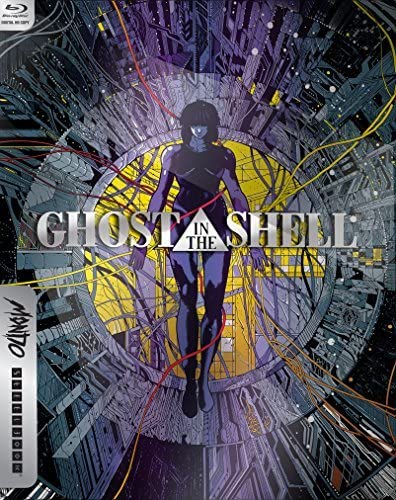
In the near future, human beings augment their bodies with mechanical and computerized parts. You can get hardened shells, robotic arms, infrared vision, and a computerized brain. These computers connect everyone to a vast electronic network. Some people forego human bodies at all and have their souls, or ghosts, connected to completely robotic bodies.
Major Motoko Kusangi is one such creature. She works for Public Security Section 9, some kind of intelligence operation for an unnamed, probably Japanese, city. Initially, her team is after a vaguely evil foreign operative who is seeking political asylum but the film drops that plot line pretty quickly so that Section 9 can focus on The Puppet Master. He’s the world’s most dangerous hacker whose body was destroyed and now lives in the film’s version of cyberspace. The plot gets pretty heavy from there and was really rather hard to follow. It didn’t help that the characters often talk in abstract concepts rather than normal dialogue.
Ghost in the Shell is hard sci-fi with a philosophical heart that’s steeped in noir visuals with heavy doses of naked breasts and Hong Kong style action. I loved it. Its traditional style animation gives it enormous depth. Where so many animated films set in giant cities tend to create generic generic background that the characters move in front of, the animators clearly spent a lot of time filling in intricate details to the city these characters live in. This is a city filled with enormous skyscrapers, filthy canals, graffiti strewn back alleys and ad-laden streets. It feels like a character unto itself.
The noir visual sensibilities fill the screen with deep shadows and creeping darkness that only hints at what might be there. It’s the kind of film that takes a break in its action midway through to play a song for several minutes while the camera takes a moment to breathe in the scenery. It’s also the sort of film that spends a lot of its run time with long discussions on what it means to be alive. The Puppet Master no longer has one body but can jump into any shell connected to the system. He ponders whether he is alive or just a computer program. The film asks deep questions about our own existence and seems rather prescient in these days where we spend more time connected to our phones than with other people.
Ghost in the Shell is the rare animated movie that was meant for adults, had more ideas than comprehensible plot lines, and enough gratuitous nudity to make Hugh Hefner blush.
The new Steelbook Blu-ray comes with some really beautiful artwork. The Steelbook itself has a really cool design and it comes with a nice slipcase that adds the title over it giving the entire thing a really cool effect. My research indicates that the disk itself is simply copied over from a previous Blu-ray release. The video looks fantastic with plenty of intricate detailing done in the animation. Likewise, the audio sounds terrific.
It should be noted that the subtitles are weird. I always switch them on while watching movies at home as my daughter often randomly makes enough noise to cover up the dialogue on the screen and in those moments it’s easier to read than rewind. Pretty quickly, I noticed that the subtitles did not match the audio here. I was listening to the English soundtrack and it was as if the actors were reading a different translation than whoever typed out the subtitles. It was distracting enough that I had to immediately turn off the subtitles.
There are zero extras on this disk. There are multiple versions of Ghost in the Shell that have been released on both DVD and Blu-ray before. Many come with an assortment of special features and extras. With this Steelbook containing no extras and having copied the audio/video from a previous release, it really comes down to how you feel about the art. If you are a collector looking for an interesting new Blu-ray to display, then this would be a welcome addition. However if you previously own the film and aren’t interested in the fancy art, then there is no reason to double dip.
Ghost in the Shell Limited Steelbook Packaging with exclusive Mondo artwork comes out on Blu-ray and Digital HD on March 14.